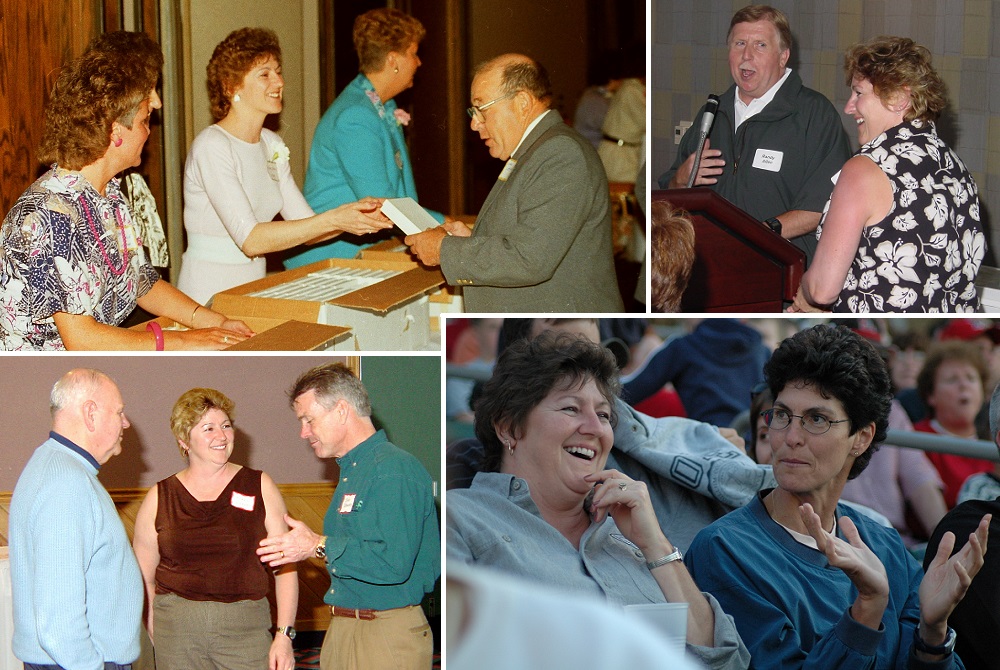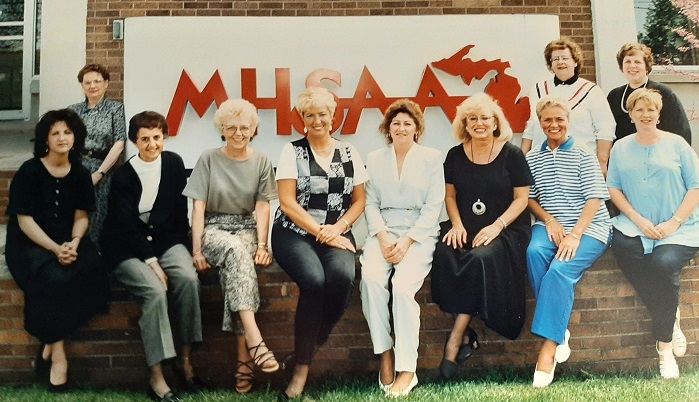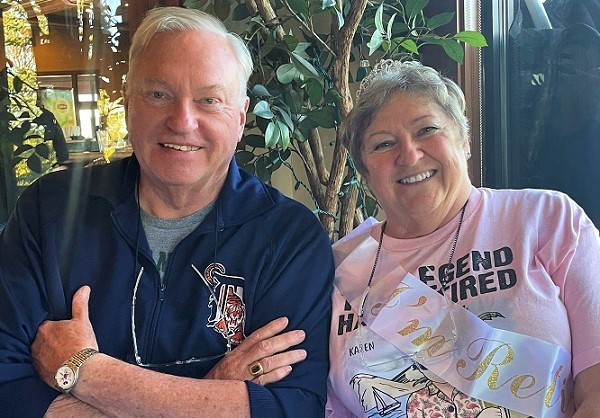
MHSAA Connecting at Junior High Level
By
Geoff Kimmerly
MHSAA.com senior editor
June 6, 2017
By Geoff Kimmerly
Second Half editor
Signs and banners were displayed at stadiums. Announcements were made to the crowd.
And most of all, questions were answered concerning the current role of the Michigan High School Athletic Association in junior high/middle school athletics – and the increased role the Association would like to take on in the future.
Throughout May, the MHSAA served as presenting sponsor at junior high/middle school track & field meets at Ravenna, Harrison, Grand Blanc and Saginaw White Pine Middle School.
This sponsorship pilot program was a first step on the path to making stronger connections with student-athletes before they reach high school. The MHSAA provided meet management with banners and other signage to hang at the events, and public address announcements on sportsmanship, multi-sport participation, officials recruitment and other notable topics affecting competitors and their families.
Also made available were printed materials on sportsmanship, officials recruitment and the benefits of taking part in junior high/middle school sports. And as part of the opportunity, the MHSAA donated grants of $500 to help with the administration of those meets – again, all in the name of getting the MHSAA message in front of students years before they reach high school.
“I couldn’t believe how many people did not realize middle schools were connected to the MHSAA. That in itself was huge for publicity,” said Damon Amey, athletic director at White Pine. “I feel that if they know we are members, they immediately know we follow a set of rules. We are student-first oriented.”
The MHSAA served 740 junior high/middle school members, plus 24 elementary schools with 6th graders participating, during the 2016-17 school year – up from 705 junior high/middle schools only a year before.
Junior high/middle schools long have been eligible for membership in the MHSAA. An entire section of the MHSAA Handbook is dedicated to them. But the Association also has turned a heavier focus toward that level over the last four years.
The MHSAA Representative Council approved the creation of a Junior High/Middle School Task Force during its December 2013 meeting, and that task force was instrumental in the addition of 6th grader participation this past school year and the lengthening of contests in some sports. The Council this spring approved a recommendation by the Junior High/Middle School Committee (a permanent committee separate from the task force) urging all MHSAA sport committees to consider opportunities to add more games and dates to middle school schedules.
Last month’s sponsorship pilot program also stemmed from this recent work.
“We need to, for the future of high school sports, get more involved at the junior high/middle school level,” said MHSAA assistant director Cody Inglis, who oversees the Junior High/Middle School Committee and led the task force. “It’s not a matter of should we, but how quickly can we get involved.”
Inglis served as something of an ambassador in setting up and attending multiple sponsored junior high/middle school meets. Because of the perception that the MHSAA is mostly associated with high school athletics, Inglis noticed some curious and questioning looks in response to the visible presence of the Association at those meets.
 But there were more positives, by far. On multiple occasions, the winners of the meets asked to have their team photos taken with the MHSAA banner on the field. One team took individual photos of each athlete holding the trophy in front of the banner as well.
But there were more positives, by far. On multiple occasions, the winners of the meets asked to have their team photos taken with the MHSAA banner on the field. One team took individual photos of each athlete holding the trophy in front of the banner as well.
While not many, Inglis did have conversations about officiating with a handful of interested people – good news as the MHSAA is always in pursuit of adding to those numbers. And his presence gave fans an opportunity to ask about the MHSAA’s role both at the high school and junior high/middle school level – and gave him the opportunity to explain how the Association works and dispel some myths.
“I love the fact that the MHSAA was at our conference track meet,” Montague NBC Middle School athletic director Jay Mulder said. “Cody did a great job in talking with parents, athletes and coaches. The presence was just enough to get people to take notice of the MHSAA.
“As a middle school AD and a middle school coach, I am very encouraged and excited to see the active role that the MHSAA is taking with middle school sports. I think that it bodes well for the future.”
Amey noted a number of opportunities with printed materials and championship medals that could further promote the MHSAA’s messaging at junior high/middle school meets. Also part of future plans is the recruitment of regional “ambassadors” – retired coaches, athletic directors and officials would be among candidates – who will travel to junior highs and middle schools in their areas and grow connections at that level.
As members, junior highs and middle schools receive the structure and support of MHSAA rules and governance, and every athlete receives catastrophic and concussion care insurance managed by the MHSAA. More interaction by these ambassadors could lead to more membership – the meet at White Pine, for example, included nearly half non-MHSAA schools – and also more benefit to members, be it additional sponsorship, off-field programs or even MHSAA-created championship events to give those athletes more opportunities to shine at this lower level and as they work toward taking that big step to high school.
“It’s been like a light bulb has gone off,” Inglis said. “The brand of the MHSAA is viewed as a high school-only brand, and it was humbling to see the power in that brand as people look to the ultimate goal.
“However we can parlay that into more of a presence and use that brand to get involved in school sports at the younger levels, that helps in that transition.”
PHOTOS: (Top) Students from Grand Blanc West Middle School, Fenton Schmidt Middle School and Linden Middle School stand together with an MHSAA banner during the Flint Metro League meet last month. (Middle) The Montague NBC Middle School girls track & field team poses with a banner after winning the West Michigan Conference championship. (Photos courtesy of the Grand Blanc and Montague schools’ athletic departments.)

Jackson's Imprint on MHSAA Stretches 45 Years, Across 4 Executive Directors
By
Geoff Kimmerly
MHSAA.com senior editor
October 5, 2022
First impressions can be significant, as many a saying goes. And Karen Brown unknowingly provided one in 1978 that helped affect the course of athletics in this state over the next 40-plus years.
A Michigan State University student named Karen Leinaar had shown up at the Michigan High School Athletic Association for a meeting about a 5K road race she was planning that was unrelated to the MHSAA except that the building provided a good meeting place – and Brown, just a year out of high school, was the first person to greet her at the old Trowbridge Road headquarters.
Seeing someone her age immediately made Leinaar more comfortable. She ended up returning to that office several times over the years, registering as an MHSAA game official while still an MSU student and then starting a career in 1982 that has included nearly 40 years as a high school athletic director and two decades of shaping policy as part of the MHSAA Representative Council.
That’s the kind of impact that’s emanated from Karen Jackson, formerly Brown, and over the last 45 years as assistant to four of the five executive directors during the MHSAA’s 98-year history. Jackson finished that run with her retirement Friday.
“She was always one that would welcome you, and whether you walked into the office or called on the phone, she always had an answer that would calm you down or provide you with the information you needed,” said Leinaar, who currently is serving as interim athletic director at Frankfort High School in addition to her duties as executive director of the Michigan Interscholastic Athletic Administrators Association.
“I remember initially calling and needing something from Mr. Norris – it was always Mr. Norris – and she could answer the question,” Leinaar added, referring to retired MHSAA executive director Vern Norris, who served in that role from 1978-86. “You didn’t want to talk to scary Mr. Norris – Vern was a wonderful man, but he was like the superintendent or principal. Karen always had the answer. … It was always that smile that made you feel like you were more than welcomed, wanted in the office, and everything is going to be OK.”
 Jackson began at the MHSAA in June 1977, two days before her graduation from long ago-closed Harry Hill High School in Lansing.
Jackson began at the MHSAA in June 1977, two days before her graduation from long ago-closed Harry Hill High School in Lansing.
Her high school sports career amounted to about half a season on the Hill varsity volleyball team as a sophomore before she had to switch gears to begin working for the Lansing Regional Chamber of Commerce as part of a school co-op program.
Jackson graduated as a co-valedictorian of Hill’s Class of 1977. Despite her academic standing, she hadn’t received much guidance at school on the possibility of college. But she had a job offer from the Chamber – and also had heard from grade-school friend Deborah Norris (Vern’s daughter) about an opening at the MHSAA.
The MHSAA was offering more money, and Jackson was hoping to buy a car – and so at 18, she became the secretary for executive director Allen W. Bush.
The title has changed over the years, from secretary to the executive director, to executive assistant, to senior executive assistant. The MHSAA’s administrative processes obviously have changed, mostly because of technology, from everything done on paper and through the mail to just about everything conducted digitally over the internet.
But many of Jackson’s most important duties at the end of her tenure resembled those she was hired to carry out nearly half a century ago.
Setting Exemplary Expectations
Bush retired a year after Jackson began, and she then assisted Norris for his eight as executive director. She served with Jack Roberts through his 32 years as executive director from 1986-2018 and then for these first 3½ under current director Mark Uyl.
She was considered the “baby” of the MHSAA staff during her first 12 years, until she turned 30 and her support staff teammates declared she wasn’t the baby anymore during a Christmas party serenade. Just about 33 years later, she’s leaving as one of two people left who worked in the old offices before the MHSAA moved to another East Lansing headquarters at Ramblewood Drive in 1996.
School sports happen thanks to a Karen Jackson or two in every community -- people who provide the unseen support that makes these programs possible every day.
For the last 45 years, she’s provided a consistent anchor for service to 1,500 schools and millions of student-athletes across Michigan.
 “She’s shaped so much of what we’ve done,” said MHSAA assistant director Kathy Vruggink Westdorp, who joined the staff during the 2003-04 school year after more than two decades working for Grand Rapids-area schools. “Her service to schools was imperative to what she was doing, and it was a valuable part for our membership. Hers was such a dedicated service, such an exemplary service – finding solutions, to do what’s needed.”
“She’s shaped so much of what we’ve done,” said MHSAA assistant director Kathy Vruggink Westdorp, who joined the staff during the 2003-04 school year after more than two decades working for Grand Rapids-area schools. “Her service to schools was imperative to what she was doing, and it was a valuable part for our membership. Hers was such a dedicated service, such an exemplary service – finding solutions, to do what’s needed.”
There are file cabinets and libraries and hard drives at the MHSAA office, the contents of which are known by only a handful of people on Earth – and Jackson perhaps the most as she did most of the sorting and maintaining of those files over the years.
For a 1996 Lansing State Journal feature on the MHSAA’s support staff, Jackson (then Yonkers) explained “there are always new challenges, new issues and controversies. It never gets boring. In the past 19 years, we’ve slowly shifted from dealing with athletic administrators, principals and superintendents to dealing with legislators, attorneys and courts.”
The last 25 years has seen much of the work swing back to providing service directly to schools. And Jackson’s mind has become part MHSAA library and part card catalog of where to find those few snippets she might not recall immediately from the last half century.
“I guess what I’m proud of is being able to find things, to know where to find things and how to find things that other people don’t,” Jackson said. “Yes, the technology has changed everything. … We used to have more schools – they used to have 40-some Detroit public schools – and there was a whole era of (litigation), but it’s calmed down now.
“I liked what I did, and it kept me on my toes – that’s for sure.”
The MHSAA is rooted in its responsibilities as a championship and eligibility rules maker, and Jackson was involved in just about every communication in those areas during her time. Tournament changes are made at Representative Council meetings, and she’s reported the minutes for at least 150 of those, including piles of special sessions as the MHSAA managed sports through the COVID-19 pandemic. Eligibility waivers are requested at Executive Committee meetings, and she’s prepared somewhere north of 505 sets of minutes for those monthly sessions even as those agendas have grown in content substantially over the years.
Then there’s all of the correspondence from those four executive directors – all with the initials “kb” or “kj” to go with “AWB” or “VLN” or “JER” and “MU.” She also was in charge of MHSAA election ballots for 35 years, served as the lead organizer of cooperative programs, helped with football tickets for a time and briefly was part of the program-selling crew at early Football Finals at the Pontiac Silverdome.
“I think I’m pretty lucky, being on the Council and Executive Committee, that I’ve been able to work with her a lot. And most athletic directors, they may not even know who she is because they may not have contact with her or do anything with her – but she’s obviously been the unsung hero of that office,” said Vic Michaels, who serves as director of physical education & athletics for the Archdiocese of Detroit and has served on the Representative Council since 2003.
“She just does so much that you don’t really know about, especially with the Council. Whenever I need anything, Karen’s the one I call. She is the history, really. She’s the keeper of that.”
Unprecedented & 'Never to be Replicated'
A longtime co-worker of Jackson, Shirley Hytinen, retired in 1998 after just a few months more than 43 years. She too had worked for four executive directors, as she began in 1955 during the Charles E. Forsythe era.
Jackson surpassed Hytinen’s tenure a few years into Uyl’s, and can readily recall some of what stood out from all four directors she’s assisted.
Bush was “really stern” – he had served in the U.S. Marines – and she said he didn’t smile much until the day he announced his retirement, when it was “like a switch turned. He was smiling and happy and joking around.”
Norris was “the sweetest guy in the world.” Jackson had bought her first house in her mid-20s and was preparing to move in with only her dad and his motor home to assist, when Norris showed up to help at 7:30 a.m. that morning to provide another set of hands.
Roberts is known by Michigan administrators and national colleagues for his writing, and Jackson said jokingly she still “cringes” when she sees a yellow legal pad. She was an important proofreader and spent the majority of her career serving with her desk just a few paces away from that of the recent National Federation Hall of Fame selection, and she attended his induction this past summer and San Antonio.
 Roberts pointed out that during the 1980s, the MHSAA would conduct nine Executive Committee meetings, each averaging fewer than 10 requests for waivers. By the end of his 32 years, there were 11 Executive Committee meetings annually – with approximately 50 waiver requests presented on average. Still, he and Jackson were able to process the meeting minutes and continue to distribute those decisions within 24 hours.
Roberts pointed out that during the 1980s, the MHSAA would conduct nine Executive Committee meetings, each averaging fewer than 10 requests for waivers. By the end of his 32 years, there were 11 Executive Committee meetings annually – with approximately 50 waiver requests presented on average. Still, he and Jackson were able to process the meeting minutes and continue to distribute those decisions within 24 hours.
“Over the more than three decades that Karen and I worked together at the MHSAA, the work became increasingly more voluminous and complicated – and Karen kept finding ways to increase our efficiency and maximize our output,” Roberts said.
Like Norris when Bush was executive director, Uyl had been part of the MHSAA staff under Roberts since 2004 before eventually moving into the corner office. After those first 15 years together, Uyl knew what a valuable person he had just a few yards away to assist in his transition, and “he just says to do this” and allows his staff to run with it, which Jackson enjoyed.
Her duties have been shifted confidently, mostly to Jamie VanDerMoere, another longtime administrative assistant who is best-known to Michigan school sports people for her leadership with the annual wrestling championship tournaments.
Jackson recently was married to Jim Jackson, and they have plans as they close in on their first anniversary – they’re hoping to travel to Italy at some point and also The Masters in Augusta, Ga., next spring. “I’m not going to miss coming to work every day, but the people,” Karen Jackson said.
And many in school sports across Michigan, although they may not realize it, will miss the contributions Jackson has made to their community over the decades including the context she’s provided as thousands of decisions have been made.
“Not only her understanding of our regulations and the processes of our regulations, but understanding why we have those things in place – when someone does something 45 years, you get a lot of historical context,” Uyl said. “What’s made her so effective is understanding the why – and that to me is something that’s almost impossible to replace.
“When an organization has been around 98 years with only five directors, it says something to have worked for four out of the five. That will never be replicated again.”
PHOTOS (Top) From top left, Karen Jackson has been a mainstay of the MHSAA for decades – serving membership, working with administrators like Randy Allen and Gina Mazzolini or serving as assistant to executive directors like Jack Roberts (right) and Vern Norris. (Middle) Jackson, sitting fourth from left, was the “baby” of the MHSAA staff after joining when she was 18. (Below) Jackson and husband Jim have plans to travel in retirement. (MHSAA archives.)

